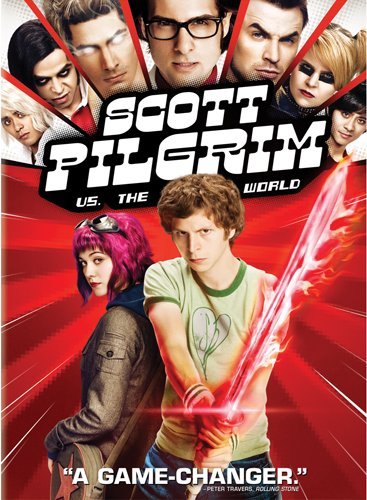All Nonfiction
- Bullying
- Books
- Academic
- Author Interviews
- Celebrity interviews
- College Articles
- College Essays
- Educator of the Year
- Heroes
- Interviews
- Memoir
- Personal Experience
- Sports
- Travel & Culture
All Opinions
- Bullying
- Current Events / Politics
- Discrimination
- Drugs / Alcohol / Smoking
- Entertainment / Celebrities
- Environment
- Love / Relationships
- Movies / Music / TV
- Pop Culture / Trends
- School / College
- Social Issues / Civics
- Spirituality / Religion
- Sports / Hobbies
All Hot Topics
- Bullying
- Community Service
- Environment
- Health
- Letters to the Editor
- Pride & Prejudice
- What Matters
- Back
Summer Guide
- Program Links
- Program Reviews
- Back
College Guide
- College Links
- College Reviews
- College Essays
- College Articles
- Back
Scott Pilgrim vs. The World
The introduction of the “videogame aesthetic” – hyper kinetic editing, ultra-somewhat cartoonish-violence, ear splitting use of sound effects – in mainstream films has been rightfully condemned by critics. Let’s face it; it’s a chore to watch those movies. As “exciting” and “adrenaline pumping” as they are, it’s actually hard to keep up. If I wanted to watch a video game, I’d go over my friend’s house and say “Oh, no, I don’t want to ruin your kill-death ratio” and just watch him play. Video game aesthetics, or what one person called “chaos cinema”, are endless hogwash of attempted excitement that are generally used to cover up and distract from the mediocrity that is everything else.
Allow me to sound somewhat like one of those guys on infomercials and say, “But what if I told you there was a movie that used ‘video game aesthetics’ to its advantage?” The difference being that the video game aesthetics that the film emulates are retro, so to speak, and resemble something more along the lines of arcade games than first person shooters. Nevertheless, you still get a similar kind of adrenaline thrill from this iteration of graphics and editing style that you may encounter elsewhere.
The film in question is Scott Pilgrim vs. the World, directed by British filmmaker Edgar Wright (Shaun of the Dead, Hot Fuzz), which was adapted from a series of comic books. The fact that it is based on a comic book, one that also tries to emulate arcade style, is telling about the film’s visual style. Not only does it feature that amusing 8-bit sound occasionally (especially in for the Universal Studios beginning), but it feels like a comic book. Sometimes the camera pans from a panel to another, other times there are clear descriptors of characters or actions or cuts in the edit that feel like a comic book. The last time something vaguely similar was pulled off well was in 2005’s Sin City, which utilized the original Frank Miller graphic novels as the actual storyboards. Scott Pilgrim does just as well, creating that same kind of nerdy, almost hipster vibe, without alienating the viewer.
I’ve babbled on long enough about technical details. But what about the film itself? Scott Pilgrim is a nerdy, kind of awkward 22 year old Canadian kid (Michael Cera playing Michael Cera again) who falls for an aloof American girl named Ramona (Mary, Elizabeth Winstead). But before he can date her, he must battle her Seven Evil Exes. Which is exactly what it sounds like.
Melding varying genres generally found in comic books, while it’s not the most premise I’ve ever seen, it is pretty interesting considering. Not only does the aesthetic make this very niche-made film work, the performances and script add more power to the punch. The witty and fast talking screenplay was written by director Wright and Michael Bacall, a script that never lets up. It’s speedy and fun, and I’ll probably get some crap for this, but it’s reminiscent of the fast talking screwball comedies of Howard Hawks. Did I mention it’s hilarious and quotable?
Michael Cera…well, he plays Michael Cera again, which is fine. It works for the character, who is, as per usual, dorky and a little awkward. Scott Pilgrim isn’t actually as awkward as Cera’ characters tend to be. It’s a fine performance, but nothing to rave about. The film pretty much rests on his shoulders, and one does come out surprised that he could actually battle those Seven Evil Exes.
Mary Elizabeth Winstead, however, is a revelation. Playing the slightly broken, rather impulsive Ramona, her character is definitely reminiscent of Kate Winslet’s broken, impulsive Clementine from Michel Gondry and Charlie Kaufman’s Eternal Sunshine of the Spotless Mind. The character could have been perceived as fairly one dimensional, but her comedic timing is great and she gives the character a tender fragility.
The supporting cast is also great. From Kieran Culkin as Scott’s gay roommate Wallace, Audra Plaza (Parks and Recreation) as the sharp and foulmouthed Julie, and the Seven Evil Exes themselves, it ends up being a supporting cast that makes the film.
The thumping, probably hipster-esque music is a highlight of the film. Partly compiled and written by Beck, it thumps, throngs, and shakes with powerful bass and a dynamic sound that is, while completely self-referential, completely fantastic to listen to. It not only fits the generally hipster feel of the film, but also its Canadian locale.
Generally speaking, almost every element of the film is rendered perfectly. It does exactly what it is supposed to do and it’s a fast and fun film, a ride that is totally original and memorable. It’s the kind of film that, if it were a game, you would definitely be scrambling for more tokens so you could play it again.
Grade: A-
Similar Articles
JOIN THE DISCUSSION
This article has 0 comments.

